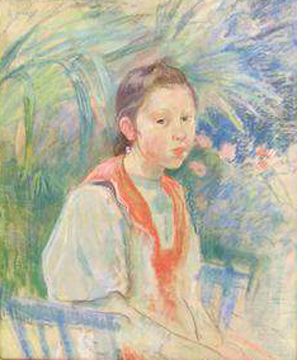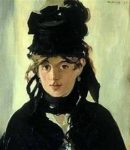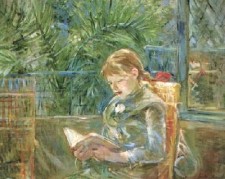
Berthe Morisot
French, 1841-1895
Portrait of Marthe Givaudon, 1892
oil stick and pastel on canvas
25 5/8 x 21 1/4 in.
SBMA, Gift of Dwight and Winifred Vedder
2006.54.9

Édouard Manet - detail from Berthe Morisot au bouquet de violettes, 1872

Morisot painted many portraits in the same style and location as the young lady in the SBMA collection, as can be seen her in Little Girl Reading, 1888, Museum of Fine Arts, St. Petersburg, Florida. The model is Jeanne Bonnet.
COMMENTS
Berthe Morisot exhibited in seven of the eight Impressionist exhibitions and was admired by other artists for her improvisational and sketch-like paintings. Her works depict maritime scenes and landscapes, and an occasional still life, but most frequently she painted her family, female friends, and young girls.
When a teenager, Morisot and her sister, Edma, studied painting and were especially drawn to Jean-Baptiste-Camille Corot, who encouraged them to paint landscapes outdoors. In 1868, shortly before Edma abandoned painting for marriage, they met Édouard Manet, who painted a series of portraits of Morisot. His friendship and his own work significantly informed Berthe’s identity as an artist. Manet’s influence is echoed in her early panoramic painting, View of Paris from the Trocadéro.
Shortly after the first Impressionist exhibition closed in Paris, the Morisot and Manet families vacationed together in Fécamp, where Morisot drew the pastel of Edma seated on the beach. It was at this time that Morisot and Manet’s younger brother, Eugène, announced their engagement. Eugène was an amateur painter and, like Morisot’s sister before him, soon became Morisot’s painting companion, allowing her to work in outdoor locations where she may not have gone if painting unaccompanied.
This pastel portrait of Marthe Givaudan is one of the last works Morisot made in the garden of her Paris home. Marthe and her brother Jules, the children of the concierge, occasionally posed for Morisot. Marthe first appears playing with Morisot’s daughter, Julie Manet, in an 1886 painting. Subsequently Marthe appeared in three paintings, three pastels, and a series of pencil and charcoal drawings. This pastel is Morisot’s most formal portrait of Marthe, then about age 11. Eugène Manet died earlier in the year, and this portrait was drawn shortly before Morisot and her daughter moved to a smaller apartment. On the eve of her death, Morisot wrote a final note to her daughter instructing her to give remembrances to friends, including Monet and Renoir as well as to the concierge. It is likely that this is the work Julie gave to the Givaudan family.
- Bill Scott, Artist and Morisot Specialist, in 75 in 25, SBMA, 2016, p. 170
Born in Bourges, Berthe Morisot was raised in a well-off Parisian household after her father, a government administrator who had studied architecture, was stationed there. Her mother arranged for her to have art lessons at an early age, and by the 1850s Morisot was painting seriously. In 1860 she met Corot, and the following year her family vacationed near his retreat at Ville d'Avray so that he could encourage her pursuits and inspire in her a taste for tonal landscapes. By 1864 Morisot's works were accepted at the Salon and she continued to show there until she joined with the Impressionists in their independent exhibition of 1874. That same year she married Eugene Manet, the younger brother of the painter Edouard, whom she had met in 1868 while sketching in the Louvre. Although the elder Manet did not exhibit with the more youthful Impressionists, he provided the most significant influence on her work. Under Manet's guidance Morisot's style evolved and she became more spontaneous in her depiction of everyday subjects. After the birth of her daughter, Julie, in 1878, children and mothers became the chief subjects in Morisot's oeuvre. Camille Pissarro, following his attendance at her funeral in 1895, wrote to his son:
You can hardly conceive how surprised we all were and how moved, too, by the disappearance of this distinguished woman, who had such a splendid feminine talent and who brought honor to our Impressionist group which is vanishing-like all things. Poor Madame Morisot, the public hardly knows her! (1)
Morisot, her husband, daughter, and servants lived in Paris on the rue de Villejust. There, in the lush garden with its potted palms and casual chairs, she painted some of her most charming works, such as The Little Girl Reading of 1888 (now in St. Petersburg, Florida). (2)
The same location is used for this depiction of her housekeeper's daughter, Marthe, who had previously appeared in several other paintings and pastels, including one of 1886 with her own daughter, Julie. (3)
In this virtuosic display of color harmonies rendered in her characteristically loose late manner, Morisot seizes on the insecure childish expression of the young girl, who is perhaps embarrassed by having so much attention paid to her by her mother's employer
Bibliography
Santa Barbara Collects/Impressions of France, Eric Zafran, SBMA, 1998, p.92
709, p.105
1. See Camille Pissarro, Letters to His Son Lucien, 1995, 262.
2. See Bataille and Wildenstein, 1961, nos. 206 and 219; and ed. Diane Lesko, Catalogue of the Collection, Museum of Fine Arts (St. Petersburg, 1993), 96-97.
3. Bataille and Wildenstein, 1961, nos. 203, 266, 566, and 567.
SBMA CURATORIAL LABELS
The young girl in this drawing, Marthe Givaudon, was the daughter of Berthe Morisot's housekeeper. Morisot especially enjoyed depicting children and women in domestic settings or lush gardens, such as the one behind her Paris home that is the setting for this portrait.
Morisot depicts the fronds of the potted palms, flowers, and other foliage with spontaneous, energetic marks but is more restrained in her handling of the girl's head and upper torso. For the rounded forms of Marthe's face and neck, she blends pale colors. In these areas, Morisot covers the canvas completely. Elsewhere, she allows the texture of the canvas to show through her drawing. In still other areas, she leaves the canvas completely bare.
The sitter slouches a bit, and gazes off to the left at nothing in particular. Her face is impassive. She keeps her arms firmly at her sides and her hands in her lap, avoiding any contact with the arms of the blue garden bench on which she sits. Though Marthe lived in the house and had posed for Morisot before, she does not appear to be entirely comfortable modeling for this drawing. Perhaps she was embarrassed at the attention from her mother's employer, or it may be that she was bored and would have preferred to be doing something else.
- SBMA INFORM #1745, 1/22/98
